Sydney Medical Centre Information System: Diagrams and Analysis Report
VerifiedAdded on 2022/11/29
|8
|1042
|387
Report
AI Summary
This report provides an analysis of the Sydney Medical Centre (SMC) information system. It begins with an executive summary outlining the need for a new information system to manage operations, patient appointments, and staff information. The report details the creation of a use case diagram, illustrating the interactions between different actors such as patients, medical staff, and administrators. The use case diagram helps visualize core functionalities and workflows within the new system. Furthermore, a context diagram is presented, depicting the system's boundaries and its interactions with external components. The context diagram clarifies the flow of information between the system and external entities, such as patients and doctors, particularly regarding appointment scheduling and information access. The report concludes by summarizing the system requirements and the application of modeling techniques such as use case and context diagrams to facilitate the design of a new information system for Sydney Medical Centre. The report references relevant academic sources to support its findings.
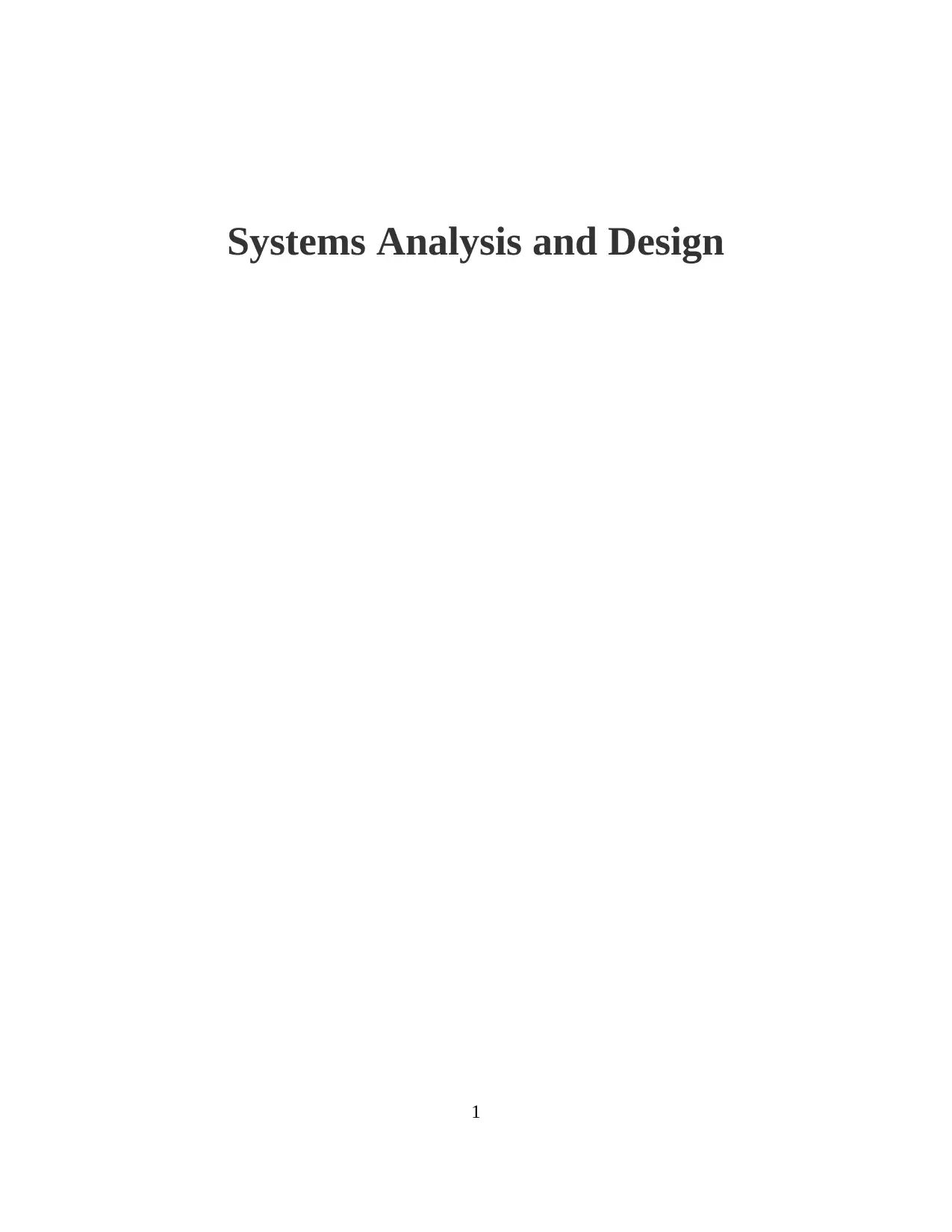
Systems Analysis and Design
1
1
Paraphrase This Document
Need a fresh take? Get an instant paraphrase of this document with our AI Paraphraser
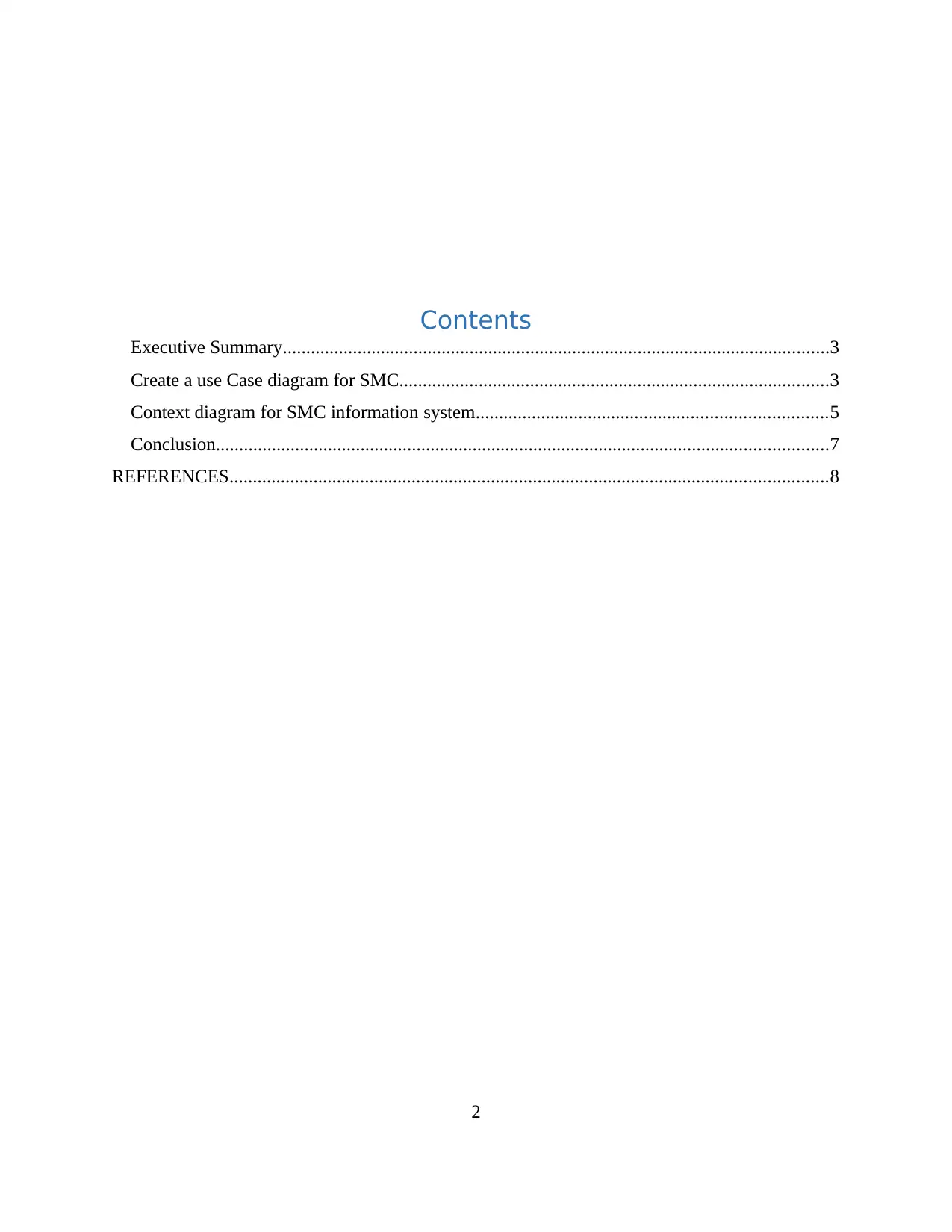
Contents
Executive Summary.....................................................................................................................3
Create a use Case diagram for SMC............................................................................................3
Context diagram for SMC information system...........................................................................5
Conclusion...................................................................................................................................7
REFERENCES................................................................................................................................8
2
Executive Summary.....................................................................................................................3
Create a use Case diagram for SMC............................................................................................3
Context diagram for SMC information system...........................................................................5
Conclusion...................................................................................................................................7
REFERENCES................................................................................................................................8
2
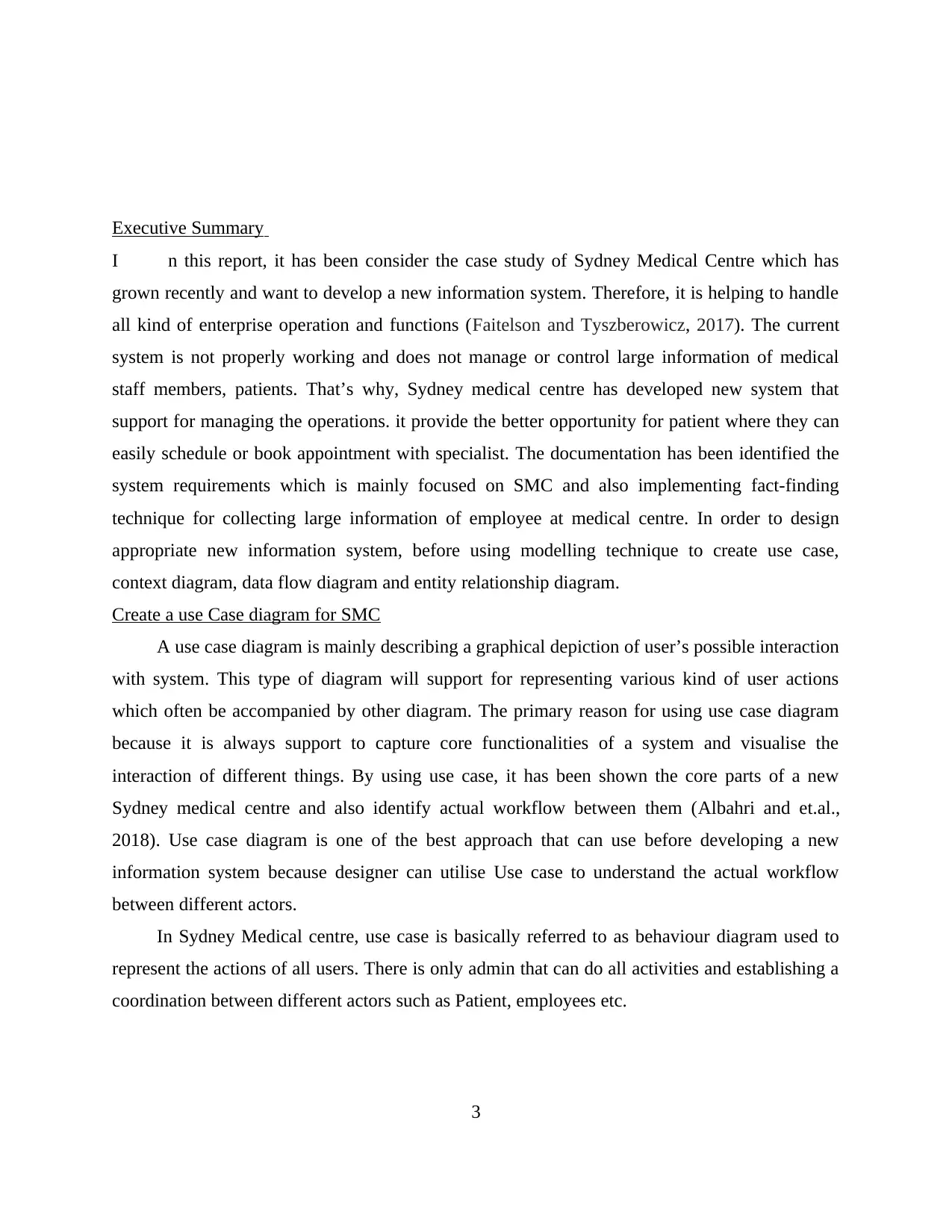
Executive Summary
I n this report, it has been consider the case study of Sydney Medical Centre which has
grown recently and want to develop a new information system. Therefore, it is helping to handle
all kind of enterprise operation and functions (Faitelson and Tyszberowicz, 2017). The current
system is not properly working and does not manage or control large information of medical
staff members, patients. That’s why, Sydney medical centre has developed new system that
support for managing the operations. it provide the better opportunity for patient where they can
easily schedule or book appointment with specialist. The documentation has been identified the
system requirements which is mainly focused on SMC and also implementing fact-finding
technique for collecting large information of employee at medical centre. In order to design
appropriate new information system, before using modelling technique to create use case,
context diagram, data flow diagram and entity relationship diagram.
Create a use Case diagram for SMC
A use case diagram is mainly describing a graphical depiction of user’s possible interaction
with system. This type of diagram will support for representing various kind of user actions
which often be accompanied by other diagram. The primary reason for using use case diagram
because it is always support to capture core functionalities of a system and visualise the
interaction of different things. By using use case, it has been shown the core parts of a new
Sydney medical centre and also identify actual workflow between them (Albahri and et.al.,
2018). Use case diagram is one of the best approach that can use before developing a new
information system because designer can utilise Use case to understand the actual workflow
between different actors.
In Sydney Medical centre, use case is basically referred to as behaviour diagram used to
represent the actions of all users. There is only admin that can do all activities and establishing a
coordination between different actors such as Patient, employees etc.
3
I n this report, it has been consider the case study of Sydney Medical Centre which has
grown recently and want to develop a new information system. Therefore, it is helping to handle
all kind of enterprise operation and functions (Faitelson and Tyszberowicz, 2017). The current
system is not properly working and does not manage or control large information of medical
staff members, patients. That’s why, Sydney medical centre has developed new system that
support for managing the operations. it provide the better opportunity for patient where they can
easily schedule or book appointment with specialist. The documentation has been identified the
system requirements which is mainly focused on SMC and also implementing fact-finding
technique for collecting large information of employee at medical centre. In order to design
appropriate new information system, before using modelling technique to create use case,
context diagram, data flow diagram and entity relationship diagram.
Create a use Case diagram for SMC
A use case diagram is mainly describing a graphical depiction of user’s possible interaction
with system. This type of diagram will support for representing various kind of user actions
which often be accompanied by other diagram. The primary reason for using use case diagram
because it is always support to capture core functionalities of a system and visualise the
interaction of different things. By using use case, it has been shown the core parts of a new
Sydney medical centre and also identify actual workflow between them (Albahri and et.al.,
2018). Use case diagram is one of the best approach that can use before developing a new
information system because designer can utilise Use case to understand the actual workflow
between different actors.
In Sydney Medical centre, use case is basically referred to as behaviour diagram used to
represent the actions of all users. There is only admin that can do all activities and establishing a
coordination between different actors such as Patient, employees etc.
3
⊘ This is a preview!⊘
Do you want full access?
Subscribe today to unlock all pages.

Trusted by 1+ million students worldwide
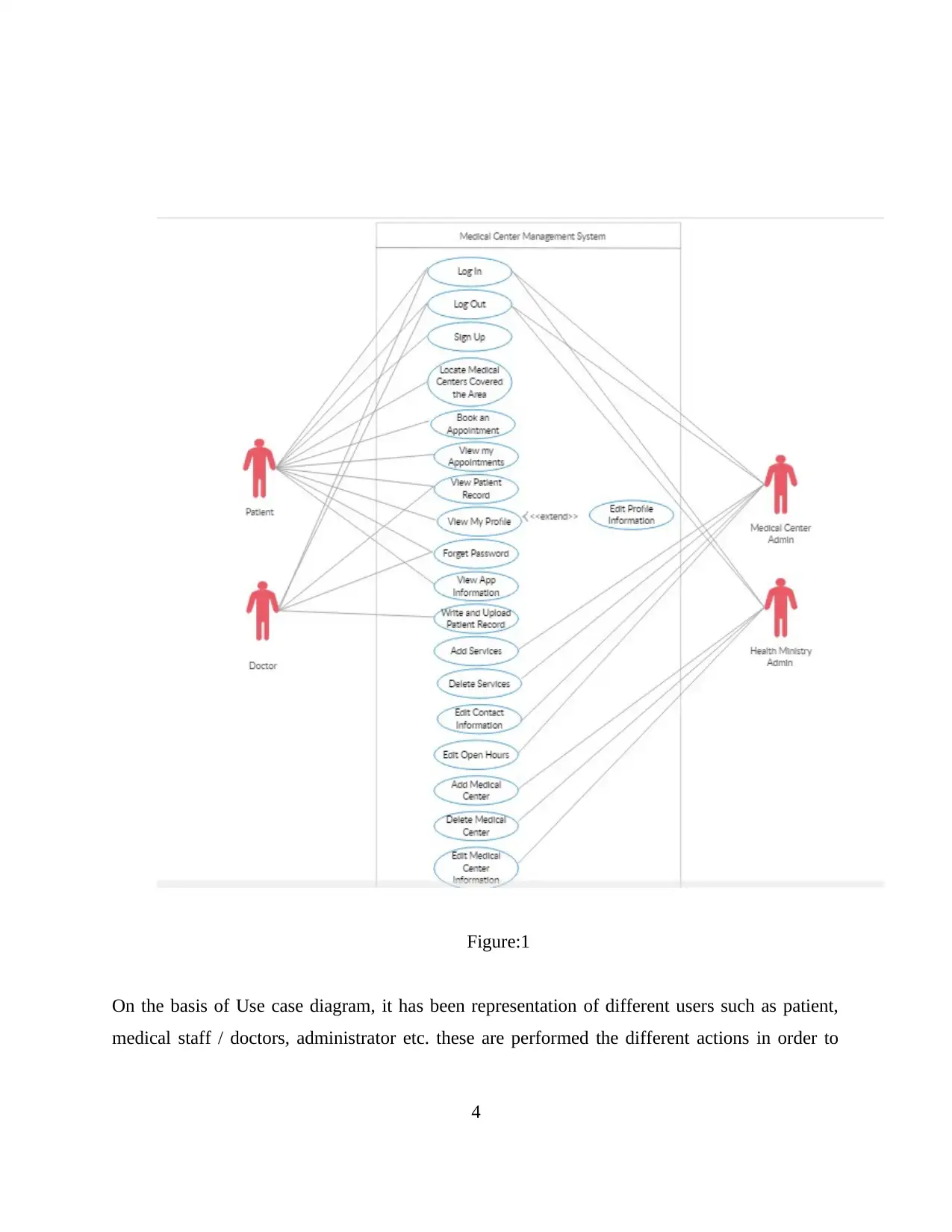
Figure:1
On the basis of Use case diagram, it has been representation of different users such as patient,
medical staff / doctors, administrator etc. these are performed the different actions in order to
4
On the basis of Use case diagram, it has been representation of different users such as patient,
medical staff / doctors, administrator etc. these are performed the different actions in order to
4
Paraphrase This Document
Need a fresh take? Get an instant paraphrase of this document with our AI Paraphraser
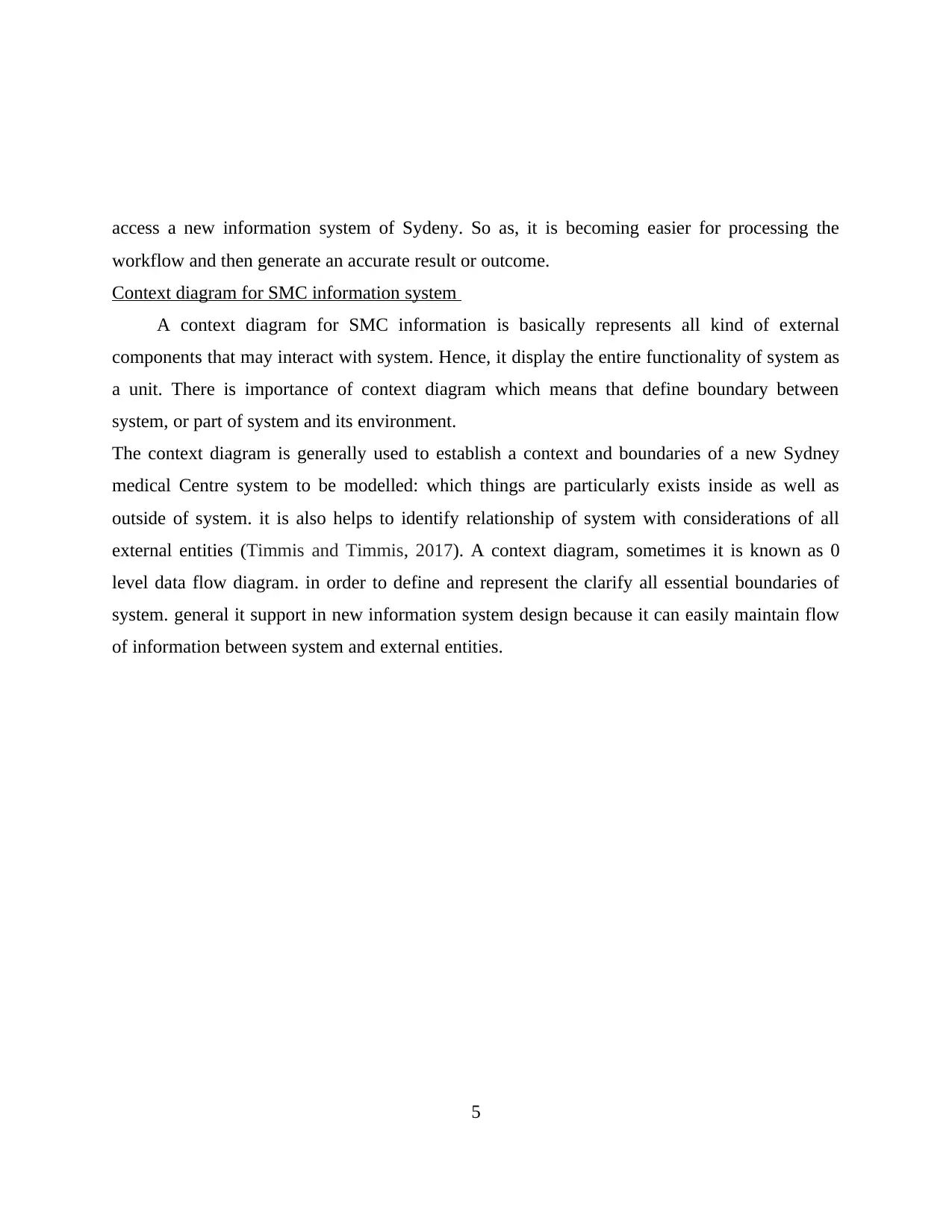
access a new information system of Sydeny. So as, it is becoming easier for processing the
workflow and then generate an accurate result or outcome.
Context diagram for SMC information system
A context diagram for SMC information is basically represents all kind of external
components that may interact with system. Hence, it display the entire functionality of system as
a unit. There is importance of context diagram which means that define boundary between
system, or part of system and its environment.
The context diagram is generally used to establish a context and boundaries of a new Sydney
medical Centre system to be modelled: which things are particularly exists inside as well as
outside of system. it is also helps to identify relationship of system with considerations of all
external entities (Timmis and Timmis, 2017). A context diagram, sometimes it is known as 0
level data flow diagram. in order to define and represent the clarify all essential boundaries of
system. general it support in new information system design because it can easily maintain flow
of information between system and external entities.
5
workflow and then generate an accurate result or outcome.
Context diagram for SMC information system
A context diagram for SMC information is basically represents all kind of external
components that may interact with system. Hence, it display the entire functionality of system as
a unit. There is importance of context diagram which means that define boundary between
system, or part of system and its environment.
The context diagram is generally used to establish a context and boundaries of a new Sydney
medical Centre system to be modelled: which things are particularly exists inside as well as
outside of system. it is also helps to identify relationship of system with considerations of all
external entities (Timmis and Timmis, 2017). A context diagram, sometimes it is known as 0
level data flow diagram. in order to define and represent the clarify all essential boundaries of
system. general it support in new information system design because it can easily maintain flow
of information between system and external entities.
5
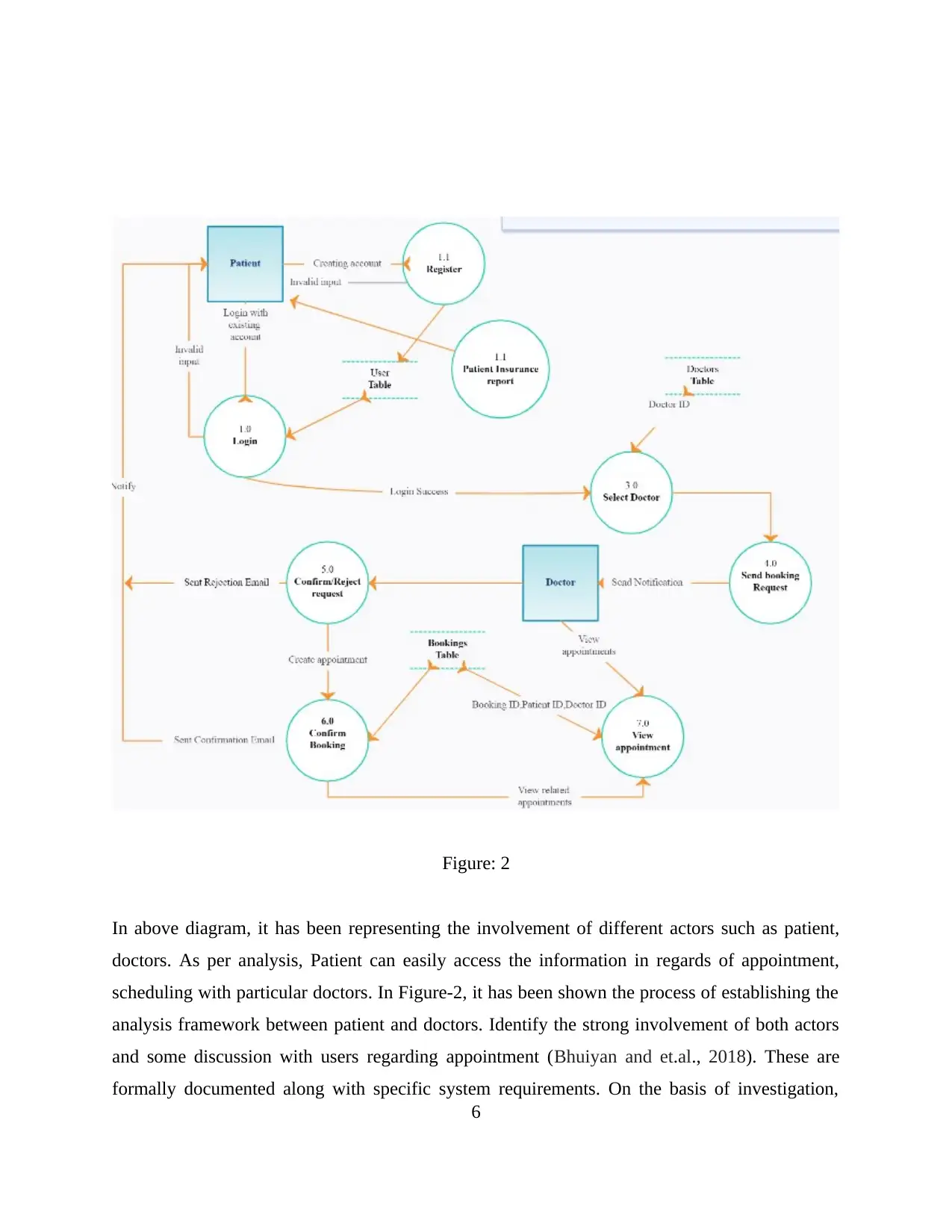
Figure: 2
In above diagram, it has been representing the involvement of different actors such as patient,
doctors. As per analysis, Patient can easily access the information in regards of appointment,
scheduling with particular doctors. In Figure-2, it has been shown the process of establishing the
analysis framework between patient and doctors. Identify the strong involvement of both actors
and some discussion with users regarding appointment (Bhuiyan and et.al., 2018). These are
formally documented along with specific system requirements. On the basis of investigation,
6
In above diagram, it has been representing the involvement of different actors such as patient,
doctors. As per analysis, Patient can easily access the information in regards of appointment,
scheduling with particular doctors. In Figure-2, it has been shown the process of establishing the
analysis framework between patient and doctors. Identify the strong involvement of both actors
and some discussion with users regarding appointment (Bhuiyan and et.al., 2018). These are
formally documented along with specific system requirements. On the basis of investigation,
6
⊘ This is a preview!⊘
Do you want full access?
Subscribe today to unlock all pages.

Trusted by 1+ million students worldwide
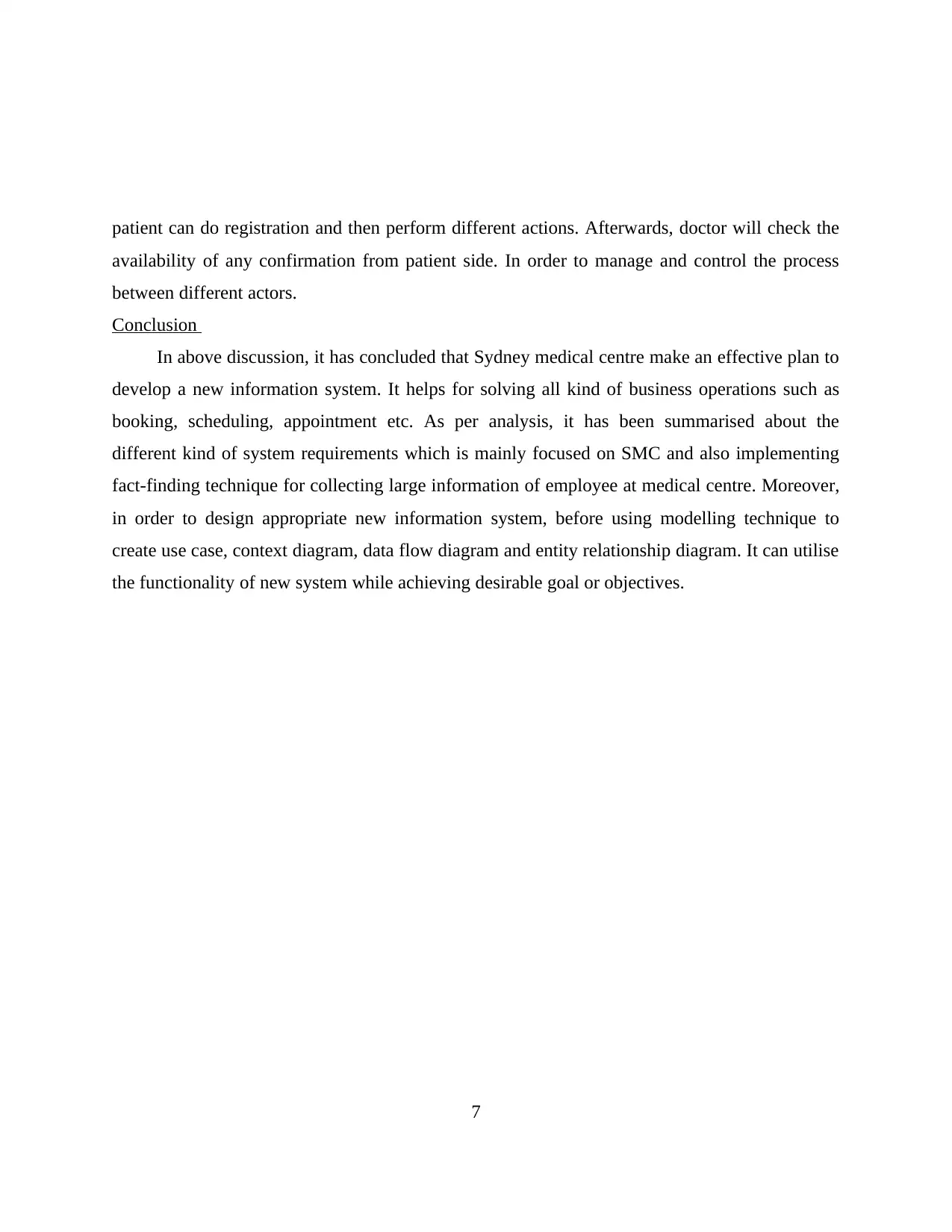
patient can do registration and then perform different actions. Afterwards, doctor will check the
availability of any confirmation from patient side. In order to manage and control the process
between different actors.
Conclusion
In above discussion, it has concluded that Sydney medical centre make an effective plan to
develop a new information system. It helps for solving all kind of business operations such as
booking, scheduling, appointment etc. As per analysis, it has been summarised about the
different kind of system requirements which is mainly focused on SMC and also implementing
fact-finding technique for collecting large information of employee at medical centre. Moreover,
in order to design appropriate new information system, before using modelling technique to
create use case, context diagram, data flow diagram and entity relationship diagram. It can utilise
the functionality of new system while achieving desirable goal or objectives.
7
availability of any confirmation from patient side. In order to manage and control the process
between different actors.
Conclusion
In above discussion, it has concluded that Sydney medical centre make an effective plan to
develop a new information system. It helps for solving all kind of business operations such as
booking, scheduling, appointment etc. As per analysis, it has been summarised about the
different kind of system requirements which is mainly focused on SMC and also implementing
fact-finding technique for collecting large information of employee at medical centre. Moreover,
in order to design appropriate new information system, before using modelling technique to
create use case, context diagram, data flow diagram and entity relationship diagram. It can utilise
the functionality of new system while achieving desirable goal or objectives.
7
Paraphrase This Document
Need a fresh take? Get an instant paraphrase of this document with our AI Paraphraser
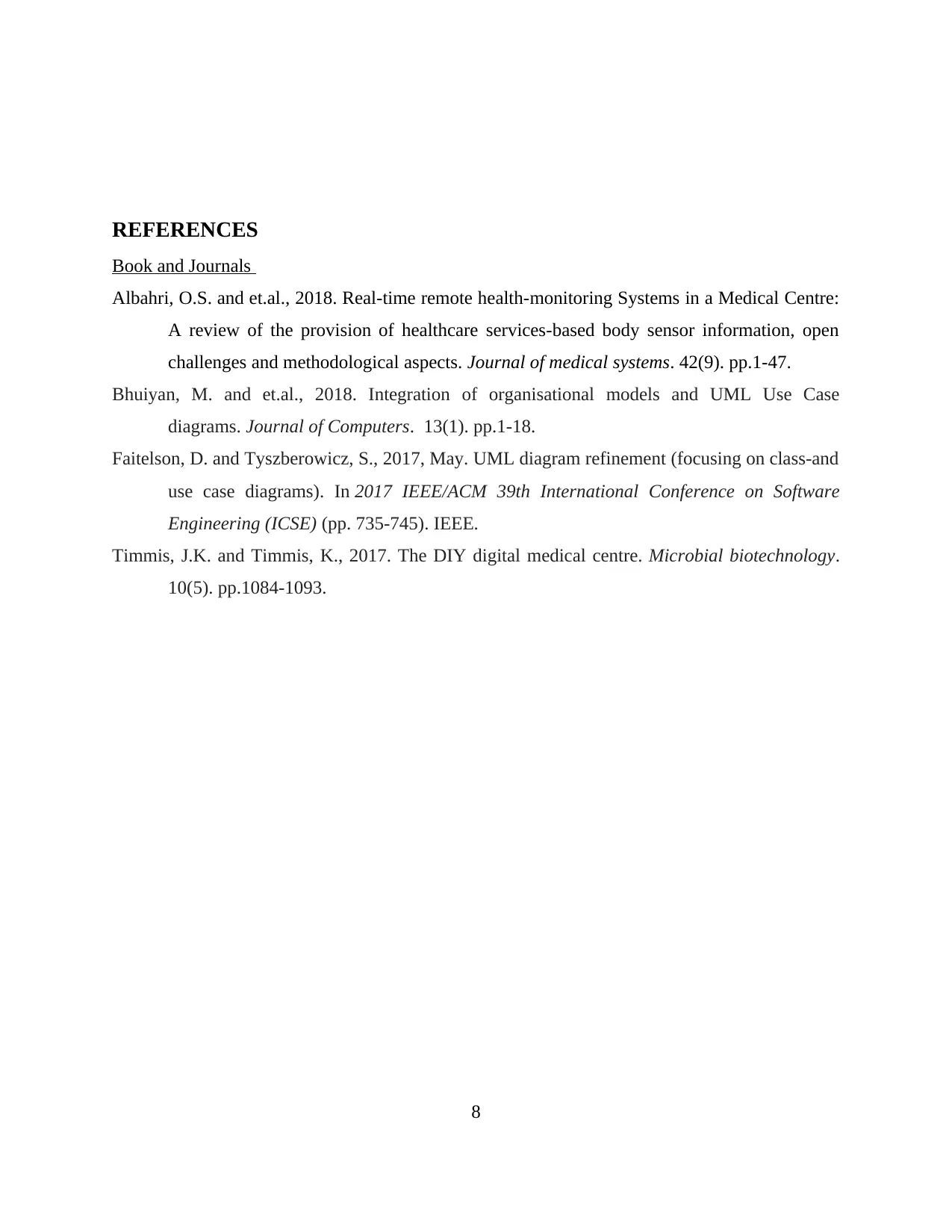
REFERENCES
Book and Journals
Albahri, O.S. and et.al., 2018. Real-time remote health-monitoring Systems in a Medical Centre:
A review of the provision of healthcare services-based body sensor information, open
challenges and methodological aspects. Journal of medical systems. 42(9). pp.1-47.
Bhuiyan, M. and et.al., 2018. Integration of organisational models and UML Use Case
diagrams. Journal of Computers. 13(1). pp.1-18.
Faitelson, D. and Tyszberowicz, S., 2017, May. UML diagram refinement (focusing on class-and
use case diagrams). In 2017 IEEE/ACM 39th International Conference on Software
Engineering (ICSE) (pp. 735-745). IEEE.
Timmis, J.K. and Timmis, K., 2017. The DIY digital medical centre. Microbial biotechnology.
10(5). pp.1084-1093.
8
Book and Journals
Albahri, O.S. and et.al., 2018. Real-time remote health-monitoring Systems in a Medical Centre:
A review of the provision of healthcare services-based body sensor information, open
challenges and methodological aspects. Journal of medical systems. 42(9). pp.1-47.
Bhuiyan, M. and et.al., 2018. Integration of organisational models and UML Use Case
diagrams. Journal of Computers. 13(1). pp.1-18.
Faitelson, D. and Tyszberowicz, S., 2017, May. UML diagram refinement (focusing on class-and
use case diagrams). In 2017 IEEE/ACM 39th International Conference on Software
Engineering (ICSE) (pp. 735-745). IEEE.
Timmis, J.K. and Timmis, K., 2017. The DIY digital medical centre. Microbial biotechnology.
10(5). pp.1084-1093.
8
1 out of 8
Related Documents
Your All-in-One AI-Powered Toolkit for Academic Success.
+13062052269
info@desklib.com
Available 24*7 on WhatsApp / Email
![[object Object]](/_next/static/media/star-bottom.7253800d.svg)
Unlock your academic potential
Copyright © 2020–2025 A2Z Services. All Rights Reserved. Developed and managed by ZUCOL.




